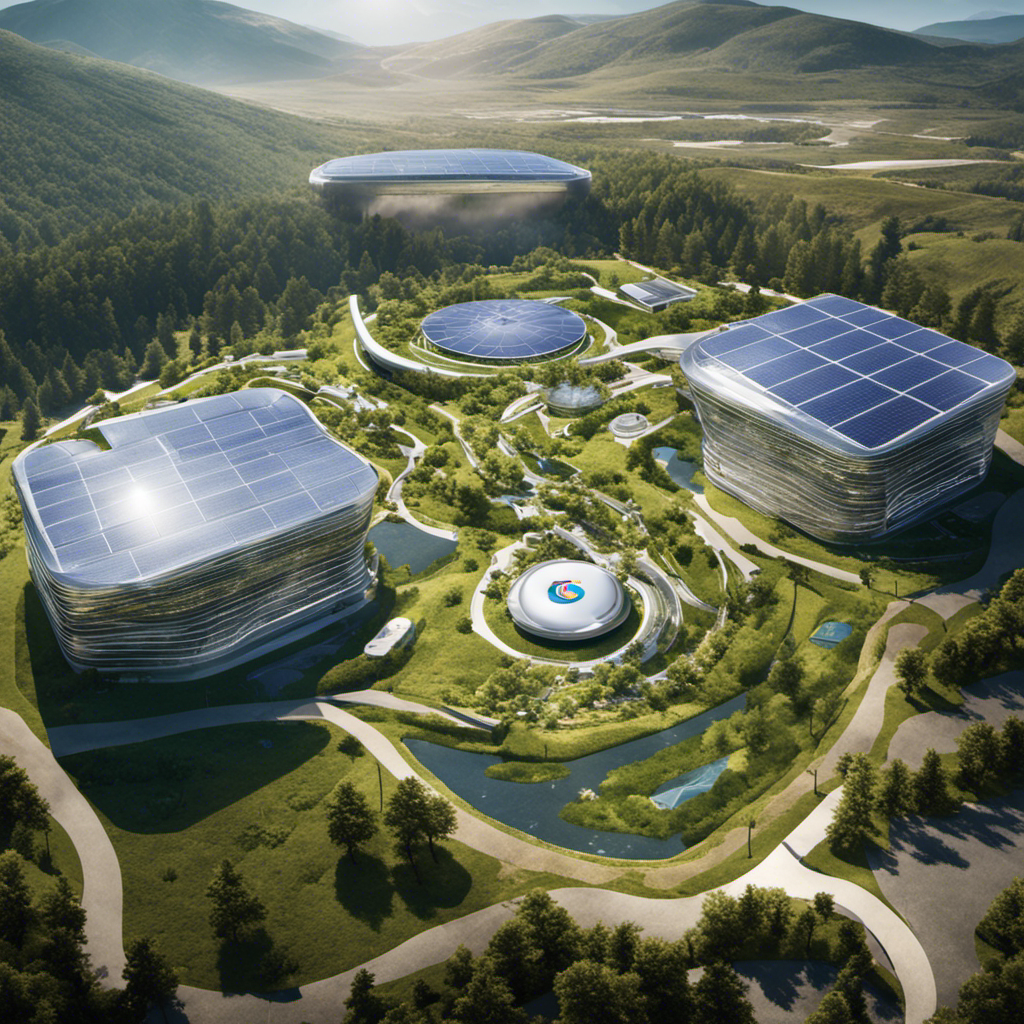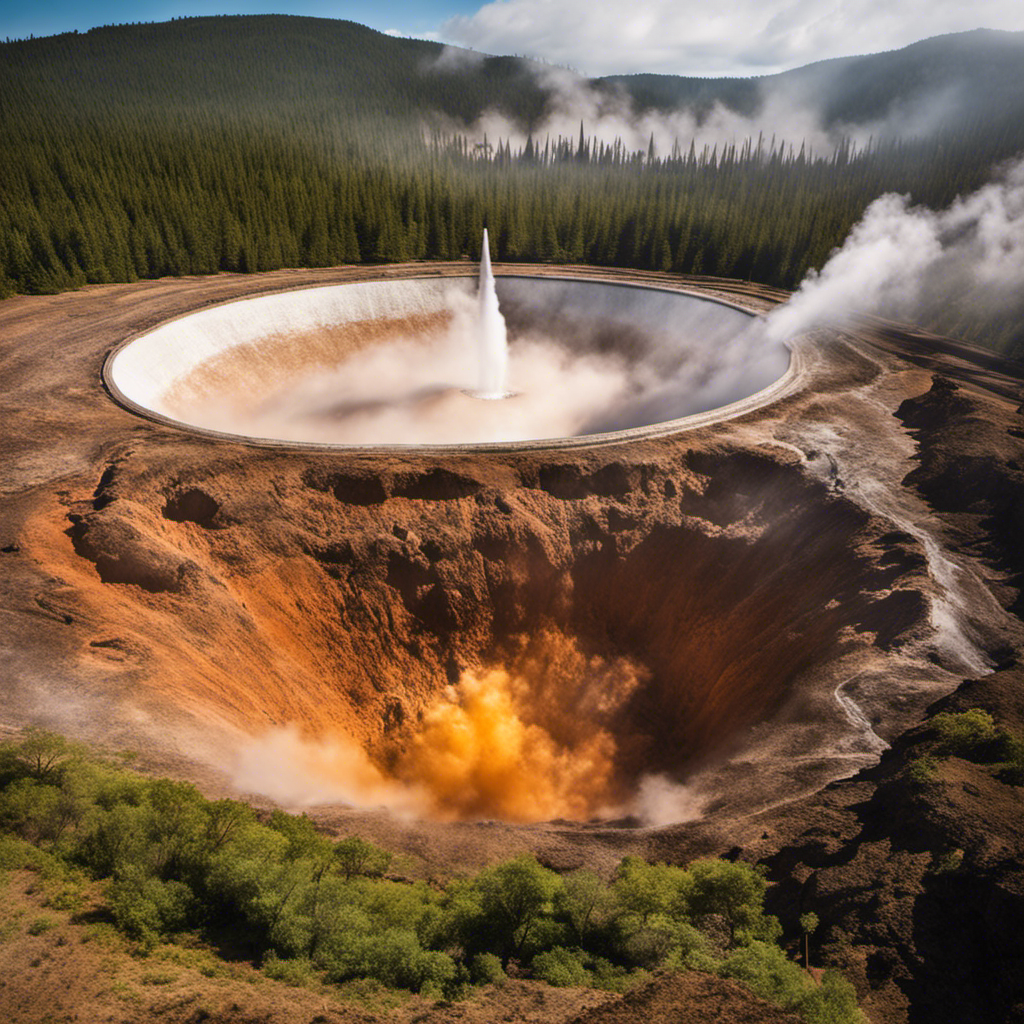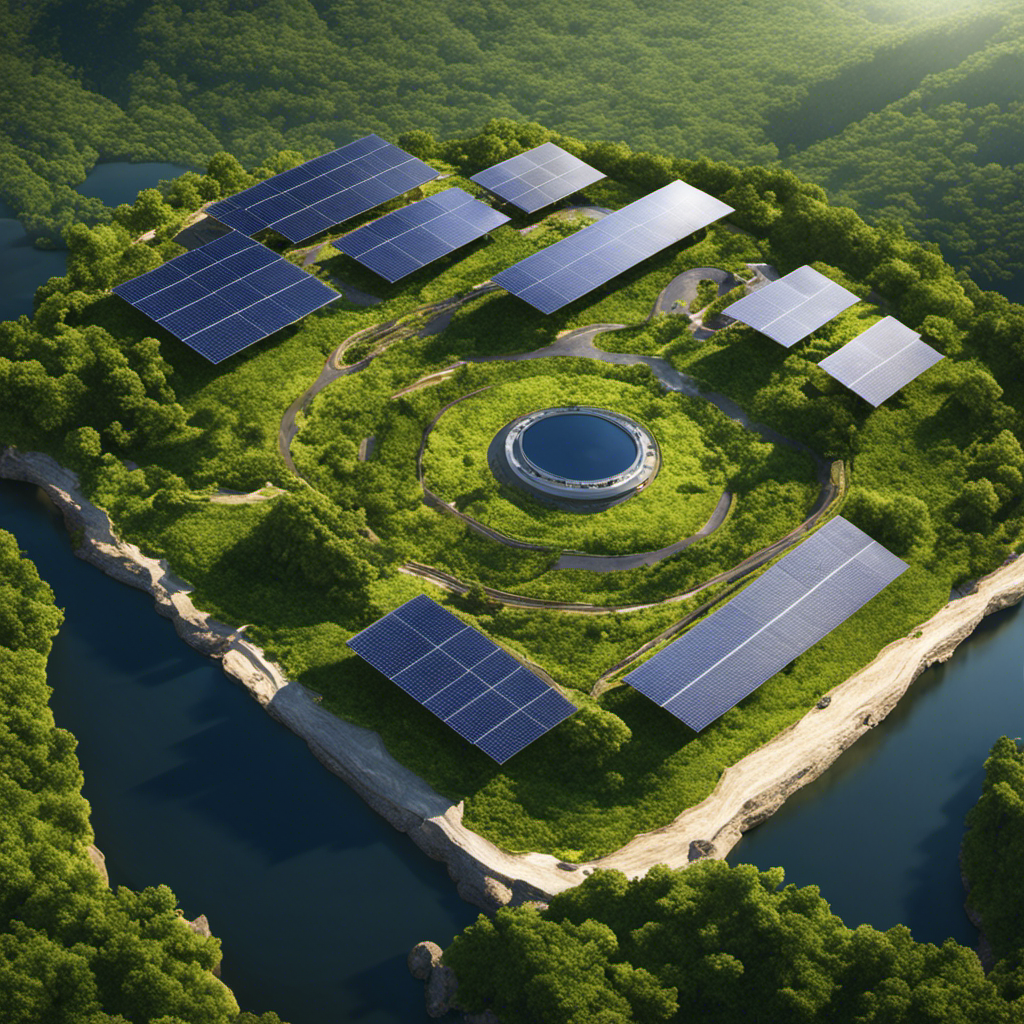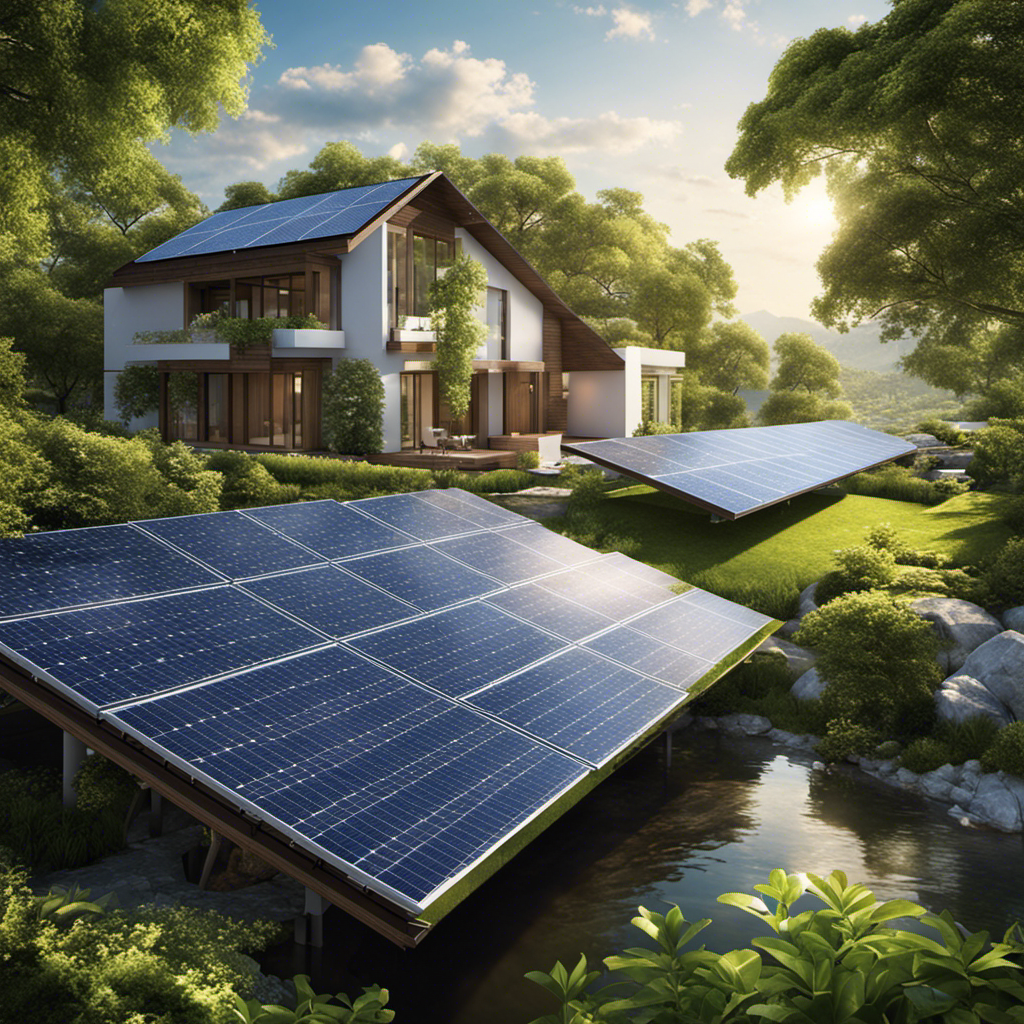Geothermal
In Which Country Are More Than 90% Of The Buildings Heated With Geothermal Energy

Imagine a country where over 90% of the buildings are heated using geothermal energy. Well, you don’t have to imagine anymore. Welcome to Iceland, where this sustainable heating solution has become a reality.
In this article, I will delve into the success story of Iceland’s geothermal industry, exploring how the country harnesses its abundant natural resources to heat buildings efficiently and sustainably.
Join me on this journey as we uncover the lessons and insights from Iceland’s path to energy independence through geothermal heating.
Key Takeaways
- Iceland is the country where more than 90% of the buildings are heated using geothermal energy.
- Geothermal energy is a renewable and sustainable solution that harnesses heat from the Earth’s core.
- Iceland’s location on the Mid-Atlantic Ridge provides abundant geothermal heat, making it an ideal location for geothermal energy.
- Geothermal energy in Iceland reduces reliance on fossil fuels, helps combat climate change, and serves as a model for other nations.
Geothermal Energy in Iceland: A Sustainable Heating Solution
Iceland’s geothermal energy system provides a sustainable heating solution for more than 90% of the buildings in the country.
Geothermal energy is a renewable solution that harnesses the heat from the Earth’s core to generate power and heat.
Iceland is uniquely positioned for geothermal energy utilization due to its location on the Mid-Atlantic Ridge, where the Earth’s tectonic plates diverge. This geological activity creates a significant amount of geothermal heat that can be tapped into.
The sustainable heating system in Iceland relies on a network of geothermal power plants and district heating systems. The geothermal energy is used directly for heating water, which is then distributed to buildings through a network of pipes.
This environmentally friendly solution reduces the reliance on fossil fuels and helps to combat climate change by significantly reducing carbon emissions.
Iceland’s Geothermal Success Story: Heating Buildings the Renewable Way
In Iceland, over 90% of buildings use renewable geothermal energy for heating. This impressive achievement is the result of Iceland’s commitment to harnessing its abundant geothermal resources.
Geothermal energy has numerous benefits, including its renewable nature and its ability to reduce greenhouse gas emissions. The advancements in geothermal technology have played a significant role in making it a viable and cost-effective option for heating buildings.
These advancements include improved drilling techniques, enhanced heat pump systems, and the utilization of geothermal heat for various applications such as space heating and hot water production.
The success of Iceland’s geothermal industry is a testament to the country’s dedication to sustainable energy solutions and serves as a model for other nations seeking to reduce their reliance on fossil fuels and transition towards a more sustainable future.
Harnessing Iceland’s Geothermal Resources: The Key to 90% Building Heating
I’m amazed at how Iceland has managed to harness its geothermal resources for heating the majority of its buildings. The benefits of utilizing geothermal energy for heating are numerous:
-
Renewable and Sustainable: Geothermal energy is a renewable resource that relies on the heat stored within the earth, making it a sustainable alternative to fossil fuel-based heating systems.
-
Cost-effective: Once the initial installation costs are covered, geothermal systems are more economical in the long run, with lower operating and maintenance expenses.
-
Reduced Carbon Footprint: By using geothermal energy, Iceland has significantly reduced its reliance on fossil fuels, resulting in a substantial decrease in greenhouse gas emissions.
-
Energy Independence: Geothermal energy provides Iceland with a reliable and locally available source of heat, reducing the country’s dependence on imported energy resources.
However, implementing geothermal energy for building heating does come with its own set of challenges. These challenges include the high upfront costs of drilling and installation, the need for skilled professionals to design and maintain the systems, and the geographical limitations of geothermal resources.
Transition: Now that we understand the benefits and challenges of implementing geothermal energy for building heating, we can explore the valuable lessons we can learn from Iceland’s successful utilization of this renewable energy source.
Lessons From Iceland: Geothermal Energy as a Solution for Building Heating
As an observer, it’s clear that Iceland’s successful utilization of geothermal energy for building heating provides valuable lessons for other regions seeking sustainable heating solutions.
Geothermal energy offers numerous benefits, making it an attractive option for building heating. Firstly, it’s a renewable energy source that produces little to no greenhouse gas emissions, reducing the carbon footprint of heating systems. Additionally, geothermal energy is a reliable and consistent source of heat, as it isn’t dependent on weather conditions or fuel availability. Furthermore, geothermal systems have a long lifespan and require minimal maintenance, resulting in cost savings over time.
However, there are also challenges associated with geothermal energy. The initial installation costs can be high, and the availability of suitable geothermal resources may vary in different regions. Additionally, the drilling and operation of geothermal wells require specialized knowledge and expertise.
Nonetheless, by addressing these challenges, other regions can learn from Iceland’s success and harness the benefits of geothermal energy for sustainable building heating.
Geothermal Heating: Iceland’s Path to Energy Independence
Iceland’s journey towards energy independence through geothermal heating has been remarkable. The country’s unique geological characteristics, including active volcanoes and geothermal hotspots, have given Iceland a tremendous advantage in harnessing geothermal energy.
Here are four key points that highlight Iceland’s geothermal potential and its impact on energy adoption in other countries:
-
Abundant Resources: Iceland is blessed with vast geothermal reservoirs, allowing for the production of clean and renewable energy. This has enabled the country to meet over 90% of its building heating needs through geothermal sources.
-
Reduced Carbon Footprint: By relying on geothermal energy, Iceland has significantly reduced its dependence on fossil fuels and the associated greenhouse gas emissions. This showcases the potential of geothermal energy as a sustainable alternative for heating in other nations.
-
Economic Benefits: Geothermal heating hasn’t only helped Iceland achieve energy independence but has also stimulated its economy. The geothermal industry has created jobs, attracted investments, and reduced the country’s energy costs.
-
Global Inspiration: Iceland’s success story has inspired other countries to explore geothermal energy as a viable heating solution. Nations with similar geothermal resources are now looking to replicate Iceland’s model, fostering a global shift towards sustainable heating practices.
Overall, Iceland’s geothermal journey serves as a shining example of how a nation can leverage its natural resources to achieve energy independence and inspire others to adopt geothermal energy for building heating.
Frequently Asked Questions
What Are the Environmental Benefits of Using Geothermal Energy for Building Heating in Iceland?
Using geothermal energy for building heating in Iceland has significant environmental benefits. It reduces greenhouse gas emissions, improves air quality, and conserves non-renewable resources. Additionally, it offers cost savings in the long run.
How Does Geothermal Energy Work to Heat Buildings in Iceland?
Geothermal energy is an efficient method for heating buildings in Iceland. Geothermal heating systems utilize the Earth’s natural heat to warm structures. This technology is widely adopted, with over 90% of buildings in the country utilizing geothermal energy.
Are There Any Challenges or Limitations to Implementing Geothermal Heating in Other Countries?
Challenges and limitations exist when implementing geothermal heating in other countries. Factors such as geological conditions, infrastructure requirements, and upfront costs must be considered. However, with proper planning, these challenges can be overcome to harness the benefits of geothermal energy.
How Has the Use of Geothermal Energy for Building Heating Impacted Iceland’s Economy?
The use of geothermal energy for building heating in Iceland has had a significant impact on its economy. It has boosted tourism and set an example for other countries to explore this sustainable energy source.
What Are Some Potential Future Developments or Advancements in Geothermal Heating Technology?
In the future, potential advancements and developments in geothermal heating technology include improved efficiency, deeper drilling techniques, and enhanced geothermal systems. These advancements will further optimize the use of geothermal energy for building heating.
Conclusion
In conclusion, Iceland’s remarkable success in heating more than 90% of its buildings with geothermal energy stands as a shining example for other nations to follow.
While some may argue that implementing geothermal heating systems on such a large scale is costly and technically challenging, the undeniable benefits of reduced carbon emissions, energy independence, and long-term cost savings make it a worthwhile investment.
By embracing geothermal energy, countries can pave the way towards a sustainable and renewable future.
Geothermal
Why Would Google Support Geothermal Energy Projects

As someone who supports renewable energy, I have always been impressed by Google’s dedication to sustainability. Learning about their backing of geothermal energy initiatives only deepened my interest.
In this article, we will explore the reasons behind Google’s endorsement of geothermal energy and the benefits it brings. By delving into the environmental advantages, technological advancements, and potential challenges, we can gain a deeper understanding of the role Google plays in shaping the future of clean energy.
Key Takeaways
- Google supports geothermal energy projects to promote clean energy and reduce its carbon footprint.
- Geothermal energy provides cost effectiveness, energy independence, and environmental benefits for Google.
- Geothermal energy has significant environmental benefits, including reduced greenhouse gas emissions and air pollution.
- Google’s advancements in geothermal technology contribute to a cleaner future, create job opportunities, and inspire further innovation in the field.
Google’s Commitment to Renewable Energy
I’m impressed by Google’s commitment to renewable energy, especially their support for geothermal energy projects. Google has made significant strides in promoting clean energy and reducing its carbon footprint through various initiatives.
One of their notable efforts is investing in geothermal energy, which harnesses the heat from the Earth’s core to generate electricity. Geothermal energy is a reliable and sustainable source of power that produces minimal greenhouse gas emissions.
Google’s geothermal energy investments not only contribute to the global shift towards renewable energy but also help diversify the clean energy portfolio. Additionally, Google has formed partnerships with clean energy companies to further advance the adoption of geothermal energy.
These initiatives demonstrate Google’s dedication to finding innovative and sustainable solutions to address the world’s energy challenges.
Advantages of Geothermal Energy for Google
As a company committed to sustainability, I’m thrilled about the advantages geothermal energy brings to Google. Here are four reasons why geothermal energy is a game-changer for us:
-
Cost effectiveness: Geothermal energy provides a stable and predictable source of power, reducing our reliance on fluctuating energy prices and ensuring long-term cost savings.
-
Energy independence: By tapping into the Earth’s natural heat, we can generate electricity on-site, reducing our dependence on external energy sources and increasing our energy self-sufficiency.
-
Environmental benefits: Geothermal energy is a clean and renewable source of power, emitting virtually no greenhouse gases or air pollutants. This aligns with our commitment to reducing our carbon footprint and combating climate change.
-
Scalability: Geothermal energy can be harnessed on a small or large scale, making it a versatile option for powering our data centers and offices worldwide.
With these advantages in mind, let’s explore the environmental benefits of geothermal energy.
Environmental Benefits of Geothermal Energy
Reducing greenhouse gas emissions and air pollutants, geothermal energy aligns with my commitment to a greener future.
Geothermal energy is a sustainable heating solution that offers significant environmental benefits. By utilizing the heat from the Earth’s core, geothermal systems produce reduced emissions compared to traditional heating methods. According to research, geothermal heating systems can reduce greenhouse gas emissions by up to 70% compared to fossil fuel-based heating systems.
This reduction in emissions is attributed to the fact that geothermal energy relies on renewable heat sources and doesn’t burn any fossil fuels. Additionally, geothermal systems don’t release any air pollutants such as sulfur dioxide, nitrogen oxides, or particulate matter, which are harmful to human health and contribute to air pollution.
Therefore, supporting geothermal energy projects is a step towards a cleaner and more sustainable future.
Google’s Role in Advancing Geothermal Technology
By investing in research and development, Google has played a crucial role in advancing the technology and efficiency of geothermal systems. Through their commitment to geothermal innovation, Google hasn’t only made significant contributions to the renewable energy sector but has also created new investment opportunities for both individuals and businesses.
Here are four reasons why Google’s involvement in geothermal technology is exciting:
-
Increased sustainability: Google’s advancements in geothermal systems contribute to a more sustainable future by reducing dependence on fossil fuels and decreasing greenhouse gas emissions.
-
Enhanced energy efficiency: Google’s research has led to improvements in the efficiency of geothermal systems, making them more cost-effective and reliable.
-
Job creation: Geothermal projects supported by Google create job opportunities in the clean energy industry, stimulating economic growth and local development.
-
Encouraging innovation: Google’s investments in geothermal research inspire others to explore and develop new technologies, fostering further innovation in the field.
With Google’s continued involvement, geothermal energy holds great promise for a greener and more sustainable future.
Potential Challenges and Solutions in Geothermal Energy Projects
I believe one potential challenge in geothermal energy projects is the need for extensive geological assessments to ensure the viability of the site.
Geothermal energy extraction and geothermal power plant construction require a thorough understanding of the subsurface geology, including the presence of suitable rock formations and the availability of reservoirs of hot water or steam.
These assessments help determine the potential resource capacity, the expected productivity of the wells, and the longevity of the project. They also help identify any potential risks, such as the presence of seismic activities or geological faults that could affect the stability of the site.
Frequently Asked Questions
How Does Geothermal Energy Compare to Other Renewable Energy Sources in Terms of Cost and Efficiency?
Geothermal energy, compared to solar energy and other renewables, offers cost advantages due to lower operational expenses. Advancements in geothermal power plant technology enhance efficiency and increase the viability of this sustainable energy source.
What Are Some Examples of Geothermal Energy Projects That Google Has Already Supported?
Examples of geothermal energy projects that Google has supported include the installation of geothermal heat pumps in their data centers and investments in geothermal power plants. The benefits include renewable energy generation and reduced carbon emissions.
What Are the Potential Economic Benefits for Local Communities Where Geothermal Energy Projects Are Implemented?
Economic benefits in local communities where geothermal energy projects are implemented include job creation and positive economic impact. It is important to analyze the potential economic benefits when considering support for geothermal energy projects.
How Does Google Ensure the Long-Term Sustainability and Reliability of Geothermal Energy Sources?
I support geothermal energy projects because they offer long-term sustainability and reliability. By investing in technological advancements, we can minimize potential environmental impacts and ensure a cleaner, more efficient energy source for the future.
Are There Any Limitations or Constraints That Google Faces When It Comes to Implementing Geothermal Energy Projects?
Implementing geothermal energy projects can have limitations and constraints. It’s crucial to assess the availability of suitable geothermal resources, infrastructure requirements, and regulatory challenges. These factors can impact the feasibility and success of Google’s support for such projects.
Conclusion
In conclusion, Google’s support for geothermal energy projects is driven by their commitment to renewable energy and the numerous advantages it offers. Geothermal energy provides a reliable and sustainable power source with minimal environmental impact.
Google is actively involved in advancing geothermal technology and overcoming potential challenges. Like a steady stream of clean energy, Google’s support for geothermal projects flows effortlessly, illuminating a path towards a greener future.
Geothermal
What Is The Main Source Of Geothermal Energy

You may believe that geothermal energy is derived from the sun or wind, but the reality is that it actually comes from the heat within the Earth.
In this article, I’ll explain the main source of geothermal energy and how we tap into it.
From geothermal reservoirs to hot rocks and magma, it’s a fascinating process that relies on understanding plate tectonics.
So, let’s dive into the depths and explore the incredible power that lies beneath our feet.
Key Takeaways
- Geothermal energy is derived from the Earth’s heat, which originates from its core where temperatures reach several thousand degrees Celsius.
- Geothermal power plants tap into the Earth’s core by drilling deep into the Earth’s crust and extracting steam or hot water to generate electricity.
- Geothermal reservoirs are located deep within the Earth’s crust and hold vast amounts of heat and potential for sustainable power generation.
- Plate tectonics directly contribute to the availability and accessibility of geothermal resources.
The Earth’s Heat
I feel the Earth’s heat is a fascinating source of geothermal energy. Geothermal power plants harness this heat and convert it into electricity, making it a valuable form of renewable energy.
The Earth’s heat originates from its core, where temperatures reach several thousand degrees Celsius. This heat is conducted through the Earth’s layers, creating geothermal reservoirs in areas with high geothermal gradients, such as volcanic regions.
Geothermal power plants utilize this heat by drilling deep into the ground to access these reservoirs. The heat is then used to generate steam, which drives turbines connected to generators, producing electricity.
This process is sustainable and clean, as it doesn’t release greenhouse gases or other harmful pollutants.
Geothermal energy has the potential to play a significant role in our transition to a more sustainable energy future.
Tapping Into the Earth’s Core
Tapping into the Earth’s core allows us to harness an incredible amount of heat and power. Earth’s core exploration is essential in understanding and utilizing geothermal energy.
The Earth’s core, located about 4,000 miles beneath the Earth’s surface, reaches temperatures up to 9,000 degrees Fahrenheit. Geothermal power plants tap into this intense heat by drilling deep into the Earth’s crust and extracting steam or hot water to generate electricity. This process requires advanced drilling techniques and technologies to reach the desired depths.
Once the heat is harnessed, it can be converted into electricity using a turbine or used directly for heating purposes. Geothermal power is a renewable and sustainable energy source that provides a constant and reliable supply of clean electricity, contributing to the global shift towards green energy solutions.
Geothermal Reservoirs
Located deep within the Earth’s crust, geothermal reservoirs hold vast amounts of heat and potential for sustainable power generation. These reservoirs are essentially underground pockets of hot water and steam that can be tapped into to produce geothermal energy.
Geothermal power plants harness this energy by drilling wells into the reservoirs and extracting the hot water or steam. The extracted fluid is then used to generate electricity through a process that involves converting the heat energy into mechanical energy and then into electrical energy.
This method of geothermal energy extraction is both efficient and environmentally friendly, as it produces minimal greenhouse gas emissions and has a small footprint. With advancements in technology and increased investment in geothermal energy, we can further harness the power of these geothermal reservoirs and contribute to a more sustainable future.
The Role of Hot Rocks and Magma
As a geothermal energy enthusiast, I find it fascinating how hot rocks and magma play a crucial role in harnessing the Earth’s natural heat for power generation. The heat trapped within the Earth’s core is transferred to the surface through rock formations that act as conduits. Volcanic activity, such as magma rising to the surface, creates pathways for this heat to escape and be utilized.
Understanding the behavior of hot rocks and magma is essential in identifying potential geothermal reservoirs and designing effective extraction systems. These rock formations act as natural reservoirs, containing the heat needed for geothermal energy production. The presence of magma provides an abundant source of heat that can be tapped into. By tapping into this natural heat source, we can generate clean and renewable energy while reducing our reliance on fossil fuels.
With this knowledge, we can now transition to understanding the relationship between plate tectonics and geothermal energy.
Understanding Plate Tectonics and Geothermal Energy
I find it fascinating how plate tectonics directly contribute to the availability and accessibility of geothermal resources.
Plate tectonics, the theory that explains the movement and interaction of Earth’s lithospheric plates, plays a crucial role in the formation and distribution of geothermal energy.
The movement of these plates creates regions where the Earth’s crust is thin, allowing heat from the mantle to rise closer to the surface.
This heat can be harnessed and converted into renewable energy through geothermal power plants.
Additionally, plate tectonics also leads to the formation of geothermal reservoirs, where heated water and steam accumulate.
These reservoirs are essential for harnessing the heat and generating electricity.
Understanding the relationship between plate tectonics and geothermal energy is vital for the development and utilization of this sustainable energy source.
Frequently Asked Questions
How Much Does It Cost to Harness Geothermal Energy for Power Generation?
Harnessing geothermal energy for power generation can be costly. A cost analysis is necessary to determine its economic viability. Factors such as drilling, infrastructure, and maintenance expenses must be considered to accurately assess the overall costs.
What Are the Environmental Impacts of Geothermal Energy Extraction?
The environmental benefits of geothermal energy extraction include reduced greenhouse gas emissions and minimal water usage. However, there are potential risks such as land subsidence and induced seismic activity that need to be carefully managed.
Can Geothermal Energy Be Used for Heating and Cooling Residential Homes?
Yes, geothermal energy can efficiently heat and cool residential homes. With advancements in geothermal energy technology, it has become a reliable and sustainable solution. Its source lies deep within the Earth, tapping into natural heat for energy production.
Are There Any Geographical Limitations to Accessing Geothermal Energy?
Geographical challenges can limit access to geothermal energy, but there are potential solutions. These challenges include the need for suitable geothermal reservoirs and geological formations. However, advancements in drilling technology and exploration techniques can help overcome these limitations.
How Is Geothermal Energy Different From Other Renewable Energy Sources?
Geothermal energy, unlike other renewables, taps into the Earth’s heat to generate power. Its advantages lie in its constant availability, low carbon emissions, and diverse applications, from heating to electricity production.
Conclusion
So, after all my research and analysis, it seems that the main source of geothermal energy is none other than the Earth itself. Who’d have thought?
We just need to tap into the Earth’s core and harness the power of its hot rocks and magma. It’s almost amusing how something as simple as plate tectonics can provide us with such a valuable renewable energy source.
Mother Nature truly has a sense of humor, doesn’t she?
Geothermal
What Are The 4 Types Of Geothermal Energy

I am going to lead you on an adventure deep underground, where a hidden energy source is waiting to be utilized. Prepare to delve into the four types of geothermal energy and discover the secrets of this potent resource.
From hydrothermal systems to enhanced geothermal systems, geothermal heat pumps, and direct use energy, each type offers unique benefits and applications.
So, let’s dive in and discover the incredible world of geothermal energy together.
Key Takeaways
- Hydrothermal Geothermal Energy is a renewable source of power that relies on underground pockets of hot water and steam.
- Enhanced Geothermal Systems (EGS) use technology advancements to tap into geothermal resources in areas where traditional hydrothermal systems are not feasible.
- Geothermal Heat Pumps utilize the constant temperature of the Earth for heating and cooling in residential and commercial buildings.
- Direct Use Geothermal Energy harnesses the Earth’s natural heat for various applications such as heating, hot water, and cooking.
Hydrothermal Geothermal Energy
Hydrothermal geothermal energy is a renewable source of power that I find fascinating. It harnesses the heat generated by the Earth’s subsurface to generate electricity. This type of geothermal energy relies on hydrothermal reservoirs, which are underground pockets of hot water and steam.
Geothermal power plants tap into these reservoirs by drilling wells and capturing the steam or hot water that rises to the surface. The steam is then used to drive turbines, which generate electricity. Geothermal power plants have the advantage of being able to operate continuously, providing a consistent and reliable source of clean energy.
Transitioning to the next section, enhanced geothermal systems (EGS) take the concept of hydrothermal geothermal energy a step further by creating their own reservoirs by injecting water into hot rocks.
Enhanced Geothermal Systems (EGS
I’m really fascinated by Enhanced Geothermal Systems (EGS) and how they have the potential to greatly expand our use of underground heat. EGS technology advancements have made it possible to tap into geothermal resources in areas where traditional hydrothermal systems are not feasible. By creating fractures in hot rock formations and injecting water into them, EGS can generate heat and produce steam for power generation. This innovative method has opened up new possibilities for geothermal energy production, allowing us to harness the Earth’s heat resources in a more efficient and sustainable manner.
| Advantages | Challenges | Applications |
|---|---|---|
| 1. High energy output | 1. Seismicity and induced earthquakes | 1. Electricity generation |
| 2. Long-term resource availability | 2. High upfront costs | 2. Industrial heating and cooling |
| 3. Minimal greenhouse gas emissions | 3. Limited commercial projects | 3. Direct use applications |
| 4. Utilizes existing geothermal resources | 4. Geographical limitations | 4. District heating |
With its numerous advantages and ongoing technological advancements, EGS is poised to become a key player in the clean energy sector. However, there are still challenges to overcome, such as managing induced seismicity and high upfront costs. Nevertheless, the potential applications of EGS range from electricity generation to industrial heating and cooling, as well as direct use applications and district heating. Now, let’s explore another fascinating aspect of geothermal energy: geothermal heat pumps.
Geothermal Heat Pumps
One of the most interesting aspects of geothermal heat pumps is how they utilize the constant temperature of the Earth to provide both heating and cooling for residential and commercial buildings.
These pumps work by transferring heat from the ground to the building during the winter months and transferring heat from the building to the ground during the summer months. This process is highly efficient, as it takes advantage of the natural heat source provided by the Earth.
Some of the benefits of geothermal heat pumps include reduced energy consumption, lower utility bills, and decreased greenhouse gas emissions. Additionally, these pumps are more durable and require less maintenance compared to traditional heating and cooling systems.
Now, let’s explore the next section on ‘direct use geothermal energy’.
Direct Use Geothermal Energy
I find it fascinating how direct use geothermal systems harness the Earth’s natural heat to provide heating and hot water for various applications, such as bathing, cooking, and space heating. These systems tap into hot water reservoirs or steam directly from the ground, eliminating the need for intermediate steps such as converting heat into electricity. This makes direct use applications of geothermal energy more efficient and cost-effective.
One common direct use application is for geothermal power plants. These plants generate electricity by using the steam or hot water from the geothermal reservoirs to drive turbines, which then produce electricity. Another direct use application is for district heating, where geothermal energy is used to heat multiple buildings or homes in a localized area. This is achieved by circulating hot water through a network of pipes, providing a sustainable and reliable source of heat.
To emphasize the benefits of direct use geothermal systems, here is a table showcasing the advantages:
| Advantages |
|---|
| Renewable energy source |
| Reduced greenhouse gas emissions |
| Reliable and consistent source of heat |
| Long lifespan and low maintenance requirements |
Direct use geothermal energy is not only environmentally friendly but also offers a reliable and sustainable solution for heating and hot water needs in various applications.
Frequently Asked Questions
How Much Does It Cost to Install and Maintain a Geothermal Heat Pump System?
Installing and maintaining a geothermal heat pump system can be costly. However, the long-term savings from its energy efficiency make it a worthwhile investment. Regular maintenance is essential for optimal performance and to prevent any potential issues.
Can Geothermal Energy Be Used in Areas With Low Ground Temperatures?
Yes, geothermal energy can be used in areas with low ground temperatures. By utilizing ground source heat pumps, the efficiency of geothermal energy can be maximized, making it suitable for various applications.
What Are the Potential Environmental Impacts of Enhanced Geothermal Systems?
Potential impacts of enhanced geothermal systems include seismic activity, induced earthquakes, and subsidence. Environmental effects may include changes in groundwater quality, emissions of greenhouse gases, and the disposal of geothermal fluids.
Are There Any Limitations or Challenges Associated With Direct Use Geothermal Energy?
There are limitations and challenges associated with direct use geothermal energy. Some limitations include the need for suitable geothermal resources and the potential for environmental impacts. Additionally, challenges may arise in the development and maintenance of geothermal systems.
How Does Hydrothermal Geothermal Energy Compare to Other Renewable Energy Sources in Terms of Efficiency and Reliability?
How does hydrothermal geothermal energy compare to other renewable energy sources in terms of efficiency and reliability? Well, when it comes to efficiency comparison, hydrothermal geothermal energy has proven to be highly efficient and reliable.
Conclusion
In conclusion, geothermal energy isn’t just limited to one type, but rather encompasses a diverse range of options.
From the powerful and extensive hydrothermal systems to the innovative and promising enhanced geothermal systems, there’s no shortage of possibilities.
Additionally, the utilization of geothermal heat pumps and direct use geothermal energy further expands our options for harnessing this renewable energy source.
With such a vast array of options, geothermal energy truly offers a boundless and sustainable solution for our energy needs.
-

 Sustainable Supply Chain Management4 months ago
Sustainable Supply Chain Management4 months agoManagEnergy Acquires GPST2030.org Domain to Strengthen Commitment to Sustainable Transport
-

 Wind Energy5 months ago
Wind Energy5 months agoHow Much Oil Does It Take To Lubricate A Wind Turbine
-

 Electric Motorbike3 months ago
Electric Motorbike3 months agoCalifornia Electric Motorcycle Laws: A Comprehensive Guide to Riding Safely
-

 Solar4 months ago
Solar4 months agoIn 2009, About What Percent Of U.S. Energy Consumption Was Supplied By Solar Energy
-

 Electricity Vehicle3 months ago
Electricity Vehicle3 months agoThe Future of Electric Vehicles: Trends and Innovations to Watch
-

 Wind Energy3 months ago
Wind Energy3 months agoRevolutionizing Highways: Wind Turbines Take the Road to Renewable Energy
-

 Solar4 months ago
Solar4 months agoWhy Should We Use Solar Energy Instead Of Fossil Fuels
-

 Solar4 months ago
Solar4 months agoHow Much Solar Energy To Go Off The Grid





















